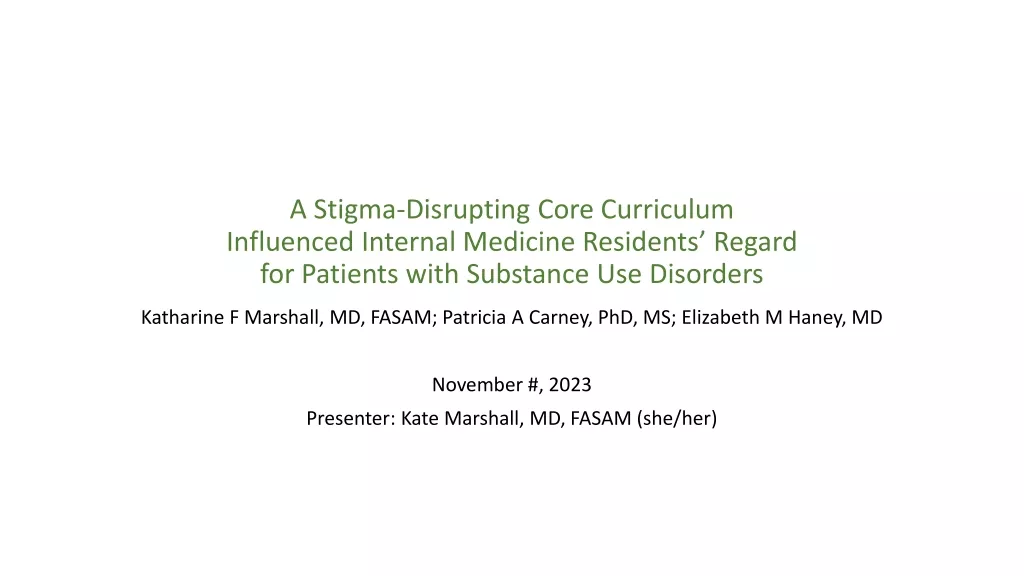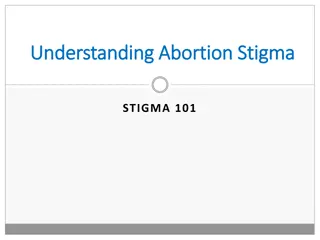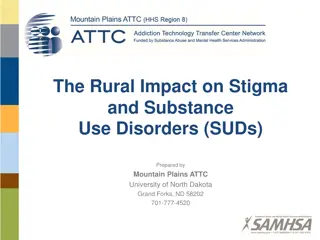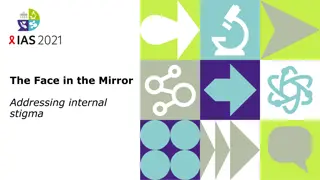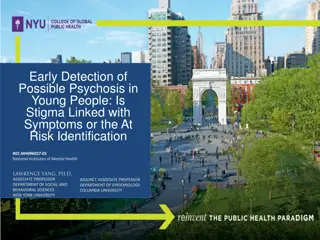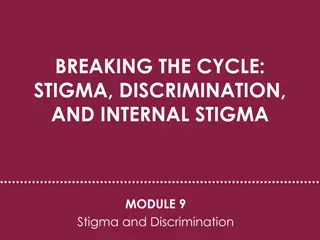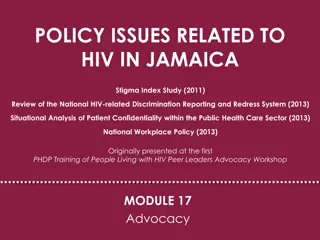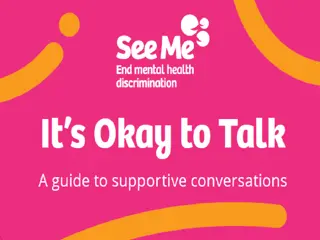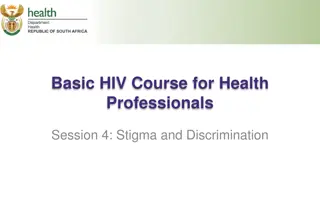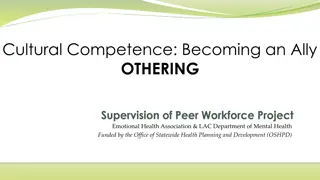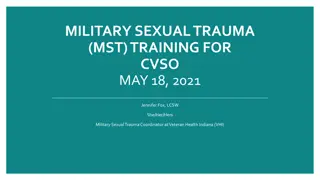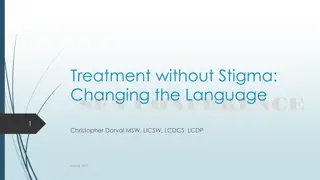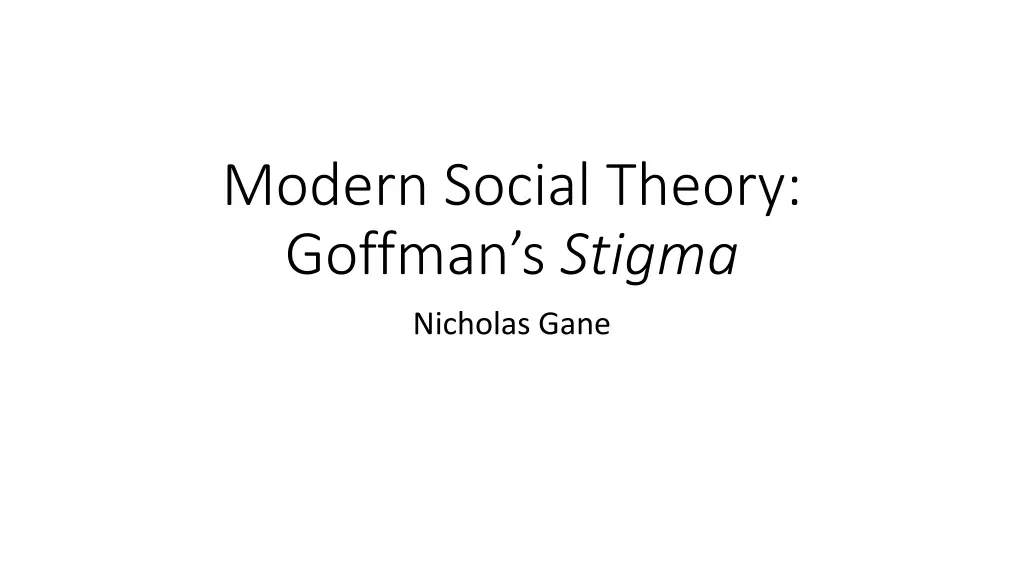
Understanding Goffman's Stigma in Modern Social Theory
Explore Erving Goffman's influential work on stigma and its relevance in contemporary society. Delve into the concept of stigma, its origins, and its implications for social acceptance and identity management. Discover how Goffman's insights can offer a unique perspective on selfhood and subjectivity within different social contexts.
Uploaded on | 1 Views
Download Presentation

Please find below an Image/Link to download the presentation.
The content on the website is provided AS IS for your information and personal use only. It may not be sold, licensed, or shared on other websites without obtaining consent from the author. If you encounter any issues during the download, it is possible that the publisher has removed the file from their server.
You are allowed to download the files provided on this website for personal or commercial use, subject to the condition that they are used lawfully. All files are the property of their respective owners.
The content on the website is provided AS IS for your information and personal use only. It may not be sold, licensed, or shared on other websites without obtaining consent from the author.
E N D
Presentation Transcript
Modern Social Theory: Goffman s Stigma Nicholas Gane
Erving Goffman Lived from 1922-82 One of the most important North American sociologists of the 20thCentury Interested in social interaction, the presentation and management of self and identity, the role of talk in interaction Three of his major works: Presentation of Self in Everyday Life (1956) Asylums: Essays on the Social Situation of Mental Patients and Other Inmates (1961) Stigma: Notes on the Management of Spoiled Identity (1963) They are very much a product of their time note the language
Why relevant to this module? Reading Goffman s work might seem like a shift from the writings on neoliberalism we have looked at so far Yes, a shift to a different level or scale of analysis a chance to read a different type of sociology But we have raised questions of subjectivity and selfhood. How are these organised, presented, and managed? Not abstract things for Goffman (as they are in some writings on neoliberalism) but key and very concrete aspects of social life Can we apply any of his insights about selfhood to the issues we have studied so far on the module (for example, to indebted selves)?
Stigma We are going to read Goffman s work Stigma. It has sold 800,000 copies since it was first published (see Imogen Tyler, Stigma, p.22) An idea/concept that is still of contemporary concern. For example, we have talked about the homo economicus, is this the norm against which selfhood and subjectivity is judged? Are individuals and social groups that do not meet this norm or the ideals of entrepreneurial and enterprising subjects who are able to take responsibility for themselves increasingly stigmatised? The first of two weeks of work on stigma. We are going to ask (this week) whether Goffman s ideas on stigma are still useful, and in Week 7 whether they are limited by a lack of political engagement with the structural inequalities and powers of US society in the 1960s?
What is stigma? Opening definition: the situation of the individual who is disqualified from full social acceptance , p.9. A term that originated in Ancient Greece: referred to bodily signs designed to expose something unusual and bad about the moral status of the signifier. The signs were cut or burnt onto the body and advertised that the bearer was a slave, a criminal or a traitor - a blemished person, ritually polluted, to be avoided, especially in public places , p.11. Goffman: Today the term is widely used in something like the original literal sense, but is applied more to the disgrace itself than to the bodily evidence of it , p.11.
Stigma as social Goffman continues: Society establishes the means of categorizing persons and the complement of attributes to be felt to be ordinary and natural for members of each of these categories , p.11. First appearances of people we don t know are often important to enable us to anticipate his category and attributes or what Goffman calls their social identity He says social identity can be of two types: virtual social identity the character we impute to an individual and actual social identity the character and attributes he could in fact be proved to possess , p.12.
Stigma as discrediting Stigma is about social relationships rather than attributes in themselves Goffman explains: The term stigma will be used to refer to an attribute that is deeply discrediting, but it should be seen that a language of relationships, not attributes is really needed , p.13. These are relationships through which people can be discredited The discredited when the stigmatized individual assumes that their differentness is known about already or is evident on the spot The discreditable when the individual assumes that it is neither known about by those present nor immediately perceivable by them , p.14.
Three types of stigma 1). physical deformities of the body 2). blemishes of individual character inferred from a known record of, for example, mental disorder, imprisonment, addiction, alcoholism, homosexuality, unemployment, suicidal attempts, and radical political behaviour 3). the tribal stigma of race, nation, and religion, these being stigma that can be transmitted through lineages and equally contaminate all members of a family , p.14. This latter point we are going to look at closely in Week 7
Stigma in action Goffman argues that what unites these three bases of stigma is the following: an individual who might have been received easily in ordinary social intercourse possesses a trait that can obtrude itself upon attention and turn those of us whom he meets away from him, breaking the claim that his other attributes have on us. He possesses a stigma, an undesired differentness from what we had anticipated. We and those who do not depart negatively from the particular expectations at issue I shall call the normals , p.15.
Stigma and discrimination This perceived or inferred departure from the norm or normal becomes the basis of a power relationship and often of discrimination Goffman writes: we believe the person with a stigma is not quite human. On this assumption we exercise varieties of discrimination, through which we effectively, if often unthinkingly reduce his life chances. We construct a stigma theory, an ideology to explain his inferiority and account for the danger he represents, sometimes rationalizing an animosity based on other differences, such as those of social class , p.15. Question: what other varieties of discrimination might there be?
Stigma and acceptance Goffman observes that stigma is often accompanied by individuals feeling shame and self-hate (based the self-perception that attributes are defiling or falling short when compared to the norm), p.18. What is at stake here is social acceptance: Those who have dealings with him fail to accord him the respect and regard which the un-contaminated aspects of his social identity have led them to anticipate extending, and have led him to anticipate receiving; he echoes this denial by finding that some of his own attributes warrant it , p.19. In other words, stigma is internalised and projected onto the self, although Goffman notes there are different ways in which stigmatized persons may respond (see pp.19-20).
Mixed contacts Goffman says he is interested specifically in mixed contacts : the moments when stigmatized and normal are in the same social situation , that is, in one another s immediate physical presence, whether in a conversation-like encounter or in the mere co-presence of an unfocused gathering , p.23. In other words: how is stigma created and managed in everyday and perhaps unavoidable social situations (different for the discredited and discreditable ?) For example: the stigmatized is likely to feel self-conscious and calculating about the impression he is making , p.25. Or: minor failings or incidental impropriety may be interpreted as a direct expression of his stigmatized differentness , p.26.
Managing situations Goffman s conclusion on how such mixed contacts are managed is as follows: In social situations with an individual known or perceived to have a stigma, we are likely to employ categorizations that do not fit, and we and he are likely to experience uneasiness. Of course, there is often significant movement from this starting point. And since the stigmatized person is likely to be more often faced with these situations than are we, he is likely to become the more adept at managing them , p.31.
Sympathetic others Goffman says that in most cases, stigmatized individuals will find that there are sympathetic others who are ready to adopt his standpoint in the world and share with him the feeling that he is human and essentially normal in spite of appearances and in spite of his own self-doubts , p.31. For example, the own : sympathetic others who share that stigma and know what it is like to have it And in some cases, an individual can use their stigma to organize the basis of their social life including the formation of associations, support networks, and social movements of different types
The own and the wise Goffman also talks of the wise : individuals who are not necessarily stigmatised themselves (for the same reasons) but understand the lives of those who are and so can sympathise with them These are possibly individuals who have experienced other kinds of stigma themselves or who work with or are related to those that are stigmatised These persons are normal but whose special situation has made them intimately privy to the secret life of the stigmitized individual and sympathetic with it, and who find themselves according a measure of acceptance, a measure of courtesy membership in the clan , p.41. Finally, in Chapter 1, Goffman talks about the moral careers over which the stigmatised are socialised and have changing conceptions of themselves through their relationships with wider society, pp.45-55.
Chapter 2: Information Control Goffman turns his attention more to the discreditable : to those whose differentness is not immediately apparent , p.57. In such cases: The issue is not that of managing tension generated during social contacts, but rather that of managing information about his failing. To display or not to display; to tell or not to tell; to let on or not to let on; to lie or not to lie; and in each case, to whom, how, when, and where , p.57. Goffman calls this management of undisclosed discrediting information about self the practice of passing , p.58.
Social information Goffman calls the type of information that is managed in the attempt to pass social information He explains: It is information about an individual. It is about his more or less abiding characteristics, as opposed to the moods, feelings, or intents that he might have at a particular moment. The information, as well as the sign through which is conveyed, is reflexive and embodied; conveyed through bodily expression in the immediate presence of those who receive the expression. Information possessing all of these qualities I will here call social , pp.58-9. Signs are complex things and can carry different meanings and status within different groups. Note the importance of the visible/visual
Personal identity This leads Goffman to define what is meant by the term personal identity He says this is born out of a mixture of positive marks that define an individual as being unique according to the way they relate to a pre- conceived image (an identity peg ) or order (fingerprints) and facts about that individual that distinguish them from everyone else, pp.73-4, i.e. uniqueness in relation to a norm and difference to everyone else Goffman writes: Personal identity has to do with the assumption that the individual can be differentiated from all others and that around this means of differentiation a single continuous record of social facts can be attached, entangled, like candy floss, becoming then the sticky substance to which still other biographical facts can be attached , pp.74-5.
Biography An individual has a biographical life line ( sustained in the minds of his intimates or in the personnel files of an organization ): he is an entity about which a record can be built up a copybook has been made for him to blot. He is anchored as an object for biography , pp.80-1. Goffman argues that social scientists, while using the idea of biography, often have not paid close attention to its general properties One assumption is that we have only one biography. Goffman: this is in sharp contrast to the multiplicity of selves one finds in the individual in looking at him from he perspective of social role, where, if role and audience are well managed, he can quite handily sustain different selves and can to a degree claim to be no longer something he was , p.81.
Individual selves The first two chapters of the book focus on the distinction between the situation of the discredited with tension to manage and the situation of the discreditable with information to manage , p.125. Also the difference between social identity (constructed by others and through which individuals are stigmatised ) and personal identity (which concerns the individual s ability to manage stigma through, for example, information control ), p.130. Goffman s focus is on the individual and biography rather than what C.W. Mills calls history. What is the connection between these things? Goffman talks of identity standards ? Where do these come from?
The politics of identity At the end of Chapter 3, there is a very (too) short section on the politics of identity, see pp.149-50. Here, Goffman says that The special situation of the stigmatized is that society tells him he is a member of the wider group, which means he is a normal human being, but that he is also different in some degree, and that it would be foolish to deny this difference. This differentness itself of course derives from society, for ordinarily before a difference can matter much it must be conceptualized collectively by a society as a whole , p.149. But how and why does this happen? What are the structural powers through which difference is marked out and sustained? What exactly is meant by the society here?
Social categorisation? To go back to a quote I cited earlier in this lecture: Society establishes the means of categorizing persons and the complement of attributes to be felt to be ordinary and natural for members of each of these categories , p.11. Surely we need to know more about these means of categorising persons and the attributes that are felt, as a consequence, to be ordinary and natural ? If we follow the position of C. Wright Mills then we need to understand the structural and historical powers that are at play in the construction of individual biographies What does Goffman say?
Minority groups Goffman is not blind to this question Towards the end of the book, he says of minority groups that Sociologically, the central issue concerning these groups is their place in the social structure; the contingencies these persons encounter in face-to-face interaction is only one part of the problem, and something that cannot itself be fully understood without reference to the history, the political development and the current policies of the group , p.151. So social structure and history do matter but these are not the primary points of concern for Goffman in his work. But why?
Society and social structure This is frustrating as Goffman reflects: certainly it seems that face-to- face interaction, at least in American society, is constructed in such a way as to be particularly prone to the kind of trouble [i.e. stigma] considered in this essay , p.164. What is special about American society? Moreover, Goffman says that the perceived undesirability of a particular personal property, and its capacity to trigger off these stigma-normal processes, has a history of its own, a history that is regularly changed by purposeful social action , p.164. What is this history, and how and why do such norms change?
Power? Interestingly, Goffman observes that stigma processes seem to have a general social function , p.164. He writes: The stigmatization of those with a bad moral record clearly can function as a means of formal social control; the stigmatization of those in certain racial, religious and ethnic groups has apparently functioned as a means of removing these minorities from various avenues of competition , p.165. Finally, (seemingly under the influence of Dorothy Smith), Goffman mentions deviations from the norm in terms of family, the age-grade system, the stereotyped role division between the sexes and segregation by class and race , p.170. Why are these considerations not central to Goffman s account?
Questions 1). What is meant by the term stigma? 2). Are there examples of stigma that you can give from contemporary social life? 3). Do you agree with Goffman that stigma is about social acceptance? 4). How, for Goffman, is stigma something that is managed? 5). What are the strengths and weaknesses of Goffman s work? 6). Do we need an approach that ties the analysis of stigma more to questions of social structure and power?


